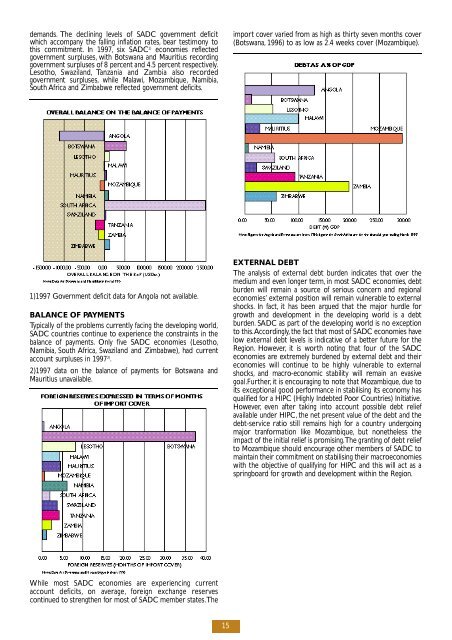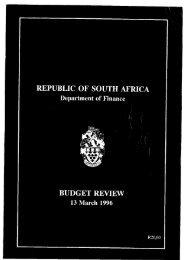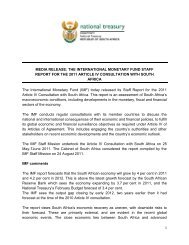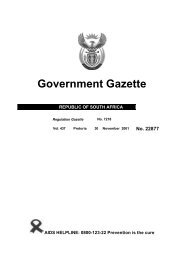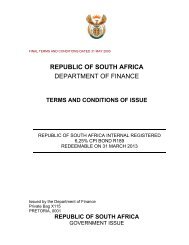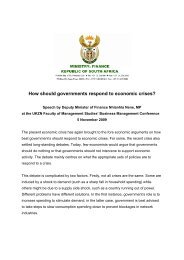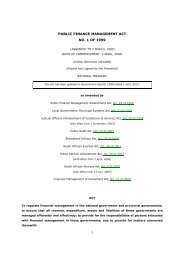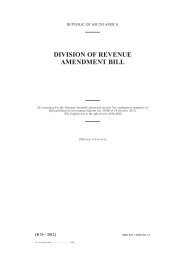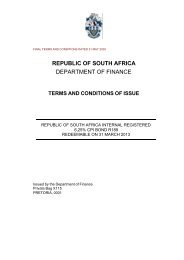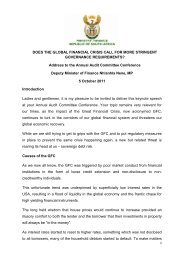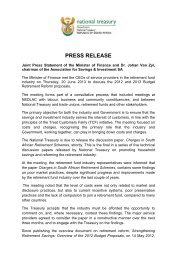1998 SOUTHERN AFRICA ECONOMIC ... - National Treasury
1998 SOUTHERN AFRICA ECONOMIC ... - National Treasury
1998 SOUTHERN AFRICA ECONOMIC ... - National Treasury
Create successful ePaper yourself
Turn your PDF publications into a flip-book with our unique Google optimized e-Paper software.
d e m a n d s .The declining levels of SADC government deficit<br />
which accompany the falling inflation rates, bear testimony to<br />
this commitment. In 1997, six SADC 1 ) economies re f l e c t e d<br />
government surpluses, with Botswana and Mauritius re c o rd i n g<br />
government surpluses of 8 percent and 4.5 percent re s p e c t i ve ly.<br />
L e s o t h o, S w a z i l a n d , Tanzania and Zambia also re c o rd e d<br />
government surpluses, while Malaw i , M o z a m b i q u e, N a m i b i a ,<br />
South Africa and Zimbabwe reflected government deficits.<br />
i m p o rt cover varied from as high as thirty seven months cove r<br />
( B o t sw a n a ,1996) to as low as 2.4 weeks cover (Mozambique).<br />
1)1997 Government deficit data for A n gola not av a i l a b l e.<br />
BALANCE OF PAY M E N T S<br />
Ty p i c a l ly of the problems curre n t ly facing the developing wo r l d ,<br />
SADC countries continue to experience the constraints in the<br />
balance of pay m e n t s . O n ly five SADC economies (Lesotho,<br />
N a m i b i a ,South A f r i c a ,Swaziland and Zimbabwe ) , had curre n t<br />
account surpluses in 1997 2 ) .<br />
2)1997 data on the balance of payments for Botswana and<br />
Mauritius unav a i l a b l e.<br />
EXTERNAL DEBT<br />
The analysis of external debt burden indicates that over the<br />
medium and even longer term, in most SADC economies, d e b t<br />
b u rden will remain a source of serious concern and re g i o n a l<br />
economies’ external position will remain vulnerable to external<br />
s h o c k s . In fact, it has been argued that the major hurdle fo r<br />
g rowth and development in the developing world is a debt<br />
b u rd e n .SADC as part of the developing world is no exception<br />
to this.A c c o rd i n g ly, the fact that most of SADC economies have<br />
l ow external debt levels is indicative of a better future for the<br />
R e g i o n . H oweve r, it is wo rth noting that four of the SADC<br />
economies are extre m e ly burdened by external debt and their<br />
economies will continue to be highly vulnerable to external<br />
s h o c k s , and macro-economic stability will remain an ev a s i ve<br />
go a l .F u rt h e r, it is encouraging to note that Mozambique, due to<br />
its exceptional good performance in stabilising its economy has<br />
qualified for a HIPC (Highly Indebted Poor Countries) Initiative.<br />
H oweve r, even after taking into account possible debt re l i e f<br />
available under HIPC, the net present value of the debt and the<br />
d e b t - s e rvice ratio still remains high for a country undergo i n g<br />
major tranformation like Mozambique, but nonetheless the<br />
impact of the initial relief is pro m i s i n g .The granting of debt re l i e f<br />
to Mozambique should encourage other members of SADC to<br />
maintain their commitment on stabilising their macro e c o n o m i e s<br />
with the objective of qualifying for HIPC and this will act as a<br />
s p r i n g b o a rd for growth and development within the Region.<br />
While most SADC economies are experiencing curre n t<br />
account deficits, on ave r a g e, fo reign exchange re s e rve s<br />
c o n t i nued to strengthen for most of SADC member states.T h e<br />
15


